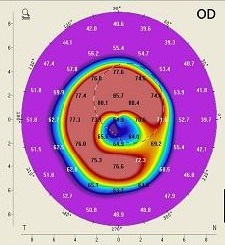The Effect of Age on Corneal Topographic Indices, Keratometry and Visual Acuity After Combined Intrastromal Corneal Ring Segment (ICRS) Implantation and Corneal Crosslinking
Medical hypothesis discovery and innovation in ophthalmology,
Vol. 9 No. 2 (2020),
4 March 2020
,
Page 135-142
Abstract
We aimed to assess age-related changes in corneal topographic indices, keratometry and visual acuity after sequential intracorneal ring segment implantation (ICRS) and crosslinking (CXL). This was a retrospective matched case-control series including 26 eyes of patients equal to or less than 18 years as the cases and 26 eyes of adult patients as control. All eyes received ICRS+CXL for progressive keratoconus. Eyes were matched regarding the keratoconus parameters and the treatment (type, number and thickness of ICRS). Data was analyzed for refractive and topographic values [uncorrected and corrected distance visual acuity (UDVA; CDVA) sphere; cylinder; spherical equivalent; maximum keratometry (Kmax); flat keratometry (Kflat); steep keratometry (Ksteep); all 7 pentacam topographic indices] preoperatively and one year postoperatively. Preoperatively, there was no significant difference for any refractive, clinical or topographic parameters between the groups except for vertical asymmetry. After one year, children had a significantly higher improvement in Ksteep (3.05D) than adults (2.10D; P=0.036) and a trend to significance for Kflat (2.7D compared to 1.78D, respectively; P=0.081). UDVA improved by 4.3 ETDRS lines in children compared to 3.3 ETDRS lines in adults and CDVA improved by 1.7 ETDRS lines in children compared to 1.2 ETDRS lines in adults, but with no statistical significance. The effects on keratometry indicated that corneal response after ICRS and CXL for keratoconus is more pronounced in young patients than adults. This assumption is also supported by functional improvement and by the fact that a few eyes (5) of some very young patients (<13years) showed highly remarkable improvements after surgery (higher than any adult eye).
References
biochemical changes. Biochim Biophys Acta. 1992;1138(3):222-8. doi: 10.1016/0925-4439(92)90041-k pmid: 1547284
Maeda N, Klyce SD, Smolek MK. Comparison of methods for detecting keratoconus using videokeratography. Arch Ophthalmol. 1995;113(7):870-4. doi: 10.1001/archopht.1995.01100070044023 pmid: 7605277
Rabinowitz YS, Rasheed K, Yang H, Elashoff J. Accuracy of ultrasonic pachymetry and videokeratography in detecting keratoconus. J Cataract Refract Surg. 1998;24(2):196-201. doi: 10.1016/s0886-3350(98)80200-9 pmid: 9530594
Jarade EF, Slim E, Cherfan C, El Rami H, Hassan T, Chelala E. Mathematical analysis of corneal remodelling after intracorneal ring surgery in keratoconus. Int J Ophthalmol. 2017;10(3):348-54. doi: 10.18240/ijo.2017.03.04 pmid: 28393023
Wollensak G, Spoerl E, Seiler T. Riboflavin/ultraviolet-a-induced collagen crosslinking for the treatment of keratoconus. Am J Ophthalmol. 2003;135(5):620-7. doi: 10.1016/s0002-9394(02)02220-1 pmid: 12719068
Gomel N, Negari S, Frucht-Pery J, Wajnsztajn D, Strassman E, Solomon A. Predictive factors for efficacy and safety in refractive surgery for myopia. PLoS One. 2018;13(12):e0208608. doi: 10.1371/journal.pone.0208608 pmid: 30550575
Kim CY, Kim MK. Effect of Sequential Intrastromal Corneal Ring Segment Implantation and Corneal Collagen Crosslinking in Corneal Ectasia. Korean J Ophthalmol. 2019;33(6):528-38. doi: 10.3341/kjo.2019.0088 pmid: 31833250
Hersh PS, Issa R, Greenstein SA. Corneal crosslinking and intracorneal ring segments for keratoconus: A randomized study of concurrent versus sequential surgery. J Cataract Refract Surg. 2019;45(6):830-9. doi: 10.1016/j.jcrs.2019.01.020 pmid: 30928252
Avni-Zauberman N, Rootman DS. Cross-linking and intracorneal ring segments--review of the literature. Eye Contact Lens. 2014;40(6):365-70. doi: 10.1097/ICL.0000000000000091 pmid: 25320956
Coskunseven E, Jankov MR, 2nd, Hafezi F, Atun S, Arslan E, Kymionis GD. Effect of treatment sequence in combined intrastromal corneal rings and corneal collagen crosslinking for keratoconus. J Cataract Refract Surg. 2009;35(12):2084-91. doi: 10.1016/j.jcrs.2009.07.008 pmid: 19969212
- Abstract Viewed: 397 times
- Full Text PDF Downloaded: 392 times


